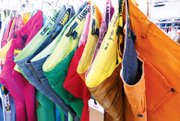Kingpins N.Y. Keeps Bright, Innovative
NEW YORK—Held one week before the Los Angeles run, Kingpins’ New York show featured a similar mix of traditional indigo denim punctuated with bright pops of color and print. The July 24–25 show, held on two floors of Center 548 in the city’s Chelsea district, run concurrently with sister show Continuum, held on a third floor in the same space.
Among the new exhibitors to Kingpins was Hong Kong–based denim mill Yellow Blue. As its name suggests, the vertical denim manufacturer and washhouse specializes in color.
“We’re very successful in Europe because of our colors,” said Stefan Fleer, Yellow Blue director, who said the company was hoping to build its presence in the United States by showing at Kingpins.
The company produces for large retailers such as Zara and is launching its own line, One Green Elephant, later this month at Project in Las Vegas. Yellow Blue can currently produce 400,000 pieces per month, according to Fleer, who said that next year the monthly capacity will increase to 700,000 pieces.
Among the company’s bright color offerings were 3D Diamond Dye, a process that applies two colors to ready-to-dye fabrics; a white pigment coating; and EcoSense75, an eco-friendly wash process that uses 75 percent less water, chemicals and energy, according to Fleer.
According to Fleer, in Europe, “color denim is more or less the standard. That’s good for us.” At the New York show, Yellow Blue was getting a good reaction, Fleer said.
“Blue denim—everyone has enough in the U.S. They gravitate to the colors,” he said.
For Ramon Rios Quintana, commercial manager for Spanish mill Santanderina, Tencel fabrications and power-stretch jacquards were popular with U.S. buyers, who were taking advantage of the stronger dollar.
“They are buying already,” Quintana said. “They’re optimistic—and the exchange rate is helping us be competitive.”
At the Cotton Inc. booth, Teresa Catherine Zugay, senior executive account manager, global supply chain marketing, was showing innovative new prints created in Cotton Inc.’s digital lab.
Among the most surprising were 3-D print treatments on jeans that seemed to float above the fabric when viewed with 3-D glasses.
Eco shift
New York–based fiber technology company Colorzen launched at the Continuum show to “get our sustainable story out,” said Michael Harari, president of the 2-year-old company. “It’s a win win. Retailers and brands are in a movement to be environmentally and sustainably.”
Colorzen pre-treats cotton fibers to create affinity between the cotton and the dye. Similar to cationic technology, Colorzen’s process is “a whole lot more than that,” Harari said.
Treated cotton can be dyed using 90 percent less water, 70 percent less energy and 95 percent fewer chemicals in a shorter dye cycle, Harari said. The result is fabric with improved colorfastness, especially on darker shades, he added.
Also showing at Continuum was Oeko-Tex, which is celebrating its 20th anniversary this year.
The independent testing service was talking to manufacturers and brands about its Oeko-Tex Standard 100 label certification, which “continues to grow,” said Dina C. Dunn, who was representing the company. Dunn said 100,000 companies are already Oeko-Tex 100 certified.
The company is also in the process of rewriting its Standard 1000, a much more rigorous standard that includes process inputs and social compliance, Dunn said.
Coverage of Kingpins show in Los Angeles can be found here.






















